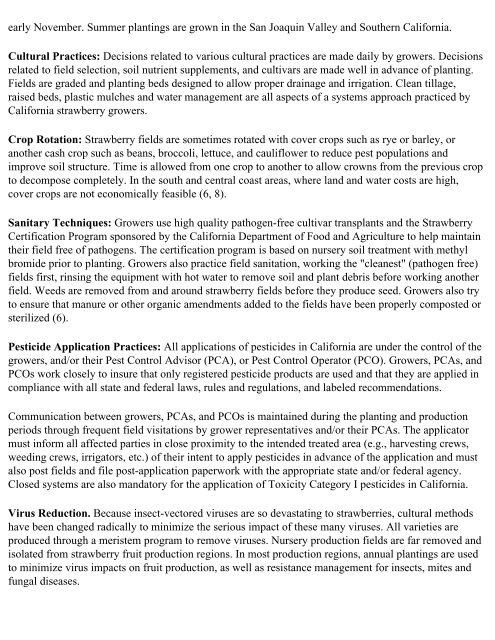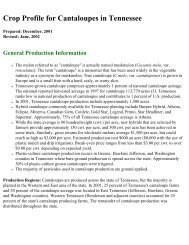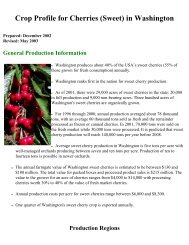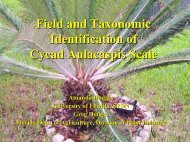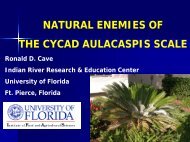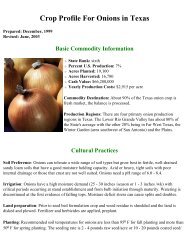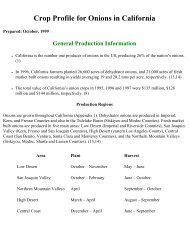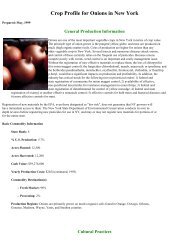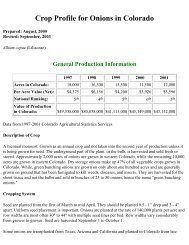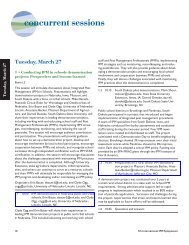Crop Profile for Strawberries in California - Regional IPM Centers
Crop Profile for Strawberries in California - Regional IPM Centers
Crop Profile for Strawberries in California - Regional IPM Centers
Create successful ePaper yourself
Turn your PDF publications into a flip-book with our unique Google optimized e-Paper software.
early November. Summer plant<strong>in</strong>gs are grown <strong>in</strong> the San Joaqu<strong>in</strong> Valley and Southern Cali<strong>for</strong>nia.<br />
Cultural Practices: Decisions related to various cultural practices are made daily by growers. Decisions<br />
related to field selection, soil nutrient supplements, and cultivars are made well <strong>in</strong> advance of plant<strong>in</strong>g.<br />
Fields are graded and plant<strong>in</strong>g beds designed to allow proper dra<strong>in</strong>age and irrigation. Clean tillage,<br />
raised beds, plastic mulches and water management are all aspects of a systems approach practiced by<br />
Cali<strong>for</strong>nia strawberry growers.<br />
<strong>Crop</strong> Rotation: Strawberry fields are sometimes rotated with cover crops such as rye or barley, or<br />
another cash crop such as beans, broccoli, lettuce, and cauliflower to reduce pest populations and<br />
improve soil structure. Time is allowed from one crop to another to allow crowns from the previous crop<br />
to decompose completely. In the south and central coast areas, where land and water costs are high,<br />
cover crops are not economically feasible (6, 8).<br />
Sanitary Techniques: Growers use high quality pathogen-free cultivar transplants and the Strawberry<br />
Certification Program sponsored by the Cali<strong>for</strong>nia Department of Food and Agriculture to help ma<strong>in</strong>ta<strong>in</strong><br />
their field free of pathogens. The certification program is based on nursery soil treatment with methyl<br />
bromide prior to plant<strong>in</strong>g. Growers also practice field sanitation, work<strong>in</strong>g the "cleanest" (pathogen free)<br />
fields first, r<strong>in</strong>s<strong>in</strong>g the equipment with hot water to remove soil and plant debris be<strong>for</strong>e work<strong>in</strong>g another<br />
field. Weeds are removed from and around strawberry fields be<strong>for</strong>e they produce seed. Growers also try<br />
to ensure that manure or other organic amendments added to the fields have been properly composted or<br />
sterilized (6).<br />
Pesticide Application Practices: All applications of pesticides <strong>in</strong> Cali<strong>for</strong>nia are under the control of the<br />
growers, and/or their Pest Control Advisor (PCA), or Pest Control Operator (PCO). Growers, PCAs, and<br />
PCOs work closely to <strong>in</strong>sure that only registered pesticide products are used and that they are applied <strong>in</strong><br />
compliance with all state and federal laws, rules and regulations, and labeled recommendations.<br />
Communication between growers, PCAs, and PCOs is ma<strong>in</strong>ta<strong>in</strong>ed dur<strong>in</strong>g the plant<strong>in</strong>g and production<br />
periods through frequent field visitations by grower representatives and/or their PCAs. The applicator<br />
must <strong>in</strong><strong>for</strong>m all affected parties <strong>in</strong> close proximity to the <strong>in</strong>tended treated area (e.g., harvest<strong>in</strong>g crews,<br />
weed<strong>in</strong>g crews, irrigators, etc.) of their <strong>in</strong>tent to apply pesticides <strong>in</strong> advance of the application and must<br />
also post fields and file post-application paperwork with the appropriate state and/or federal agency.<br />
Closed systems are also mandatory <strong>for</strong> the application of Toxicity Category I pesticides <strong>in</strong> Cali<strong>for</strong>nia.<br />
Virus Reduction. Because <strong>in</strong>sect-vectored viruses are so devastat<strong>in</strong>g to strawberries, cultural methods<br />
have been changed radically to m<strong>in</strong>imize the serious impact of these many viruses. All varieties are<br />
produced through a meristem program to remove viruses. Nursery production fields are far removed and<br />
isolated from strawberry fruit production regions. In most production regions, annual plant<strong>in</strong>gs are used<br />
to m<strong>in</strong>imize virus impacts on fruit production, as well as resistance management <strong>for</strong> <strong>in</strong>sects, mites and<br />
fungal diseases.


